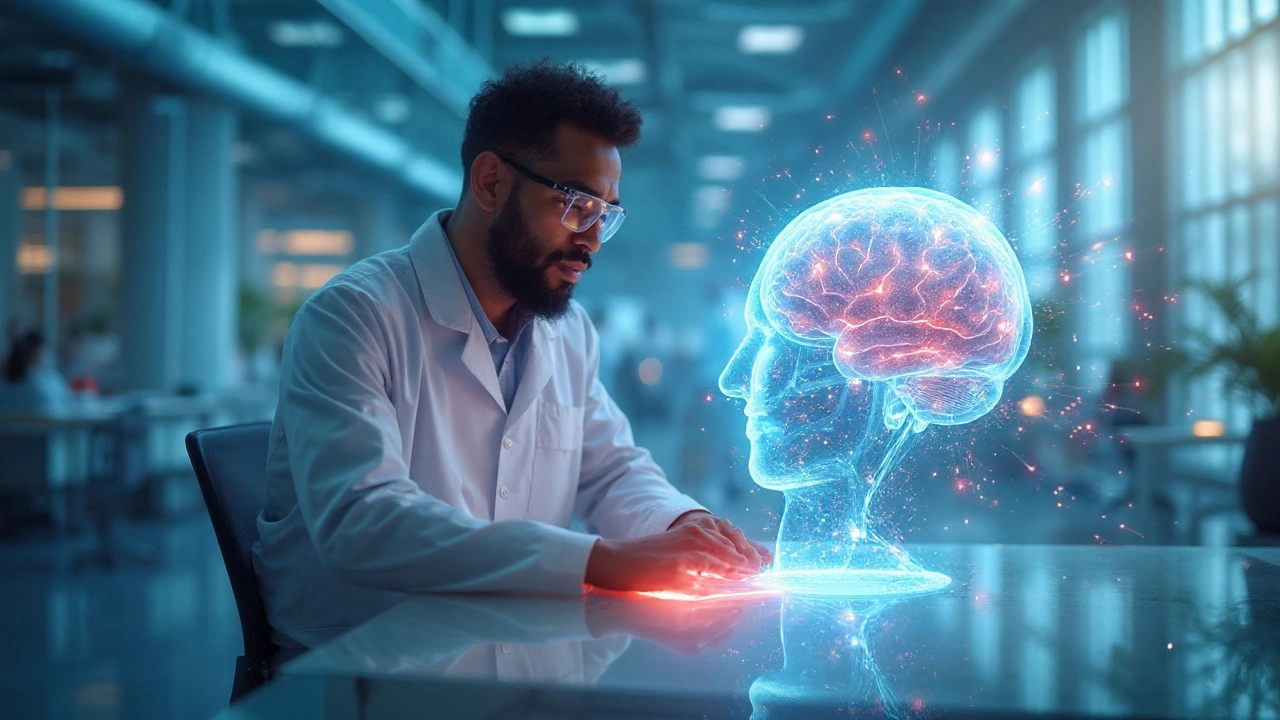Piracetam and Creativity: How This Nootropic Impacts Problem Solving
 Aug, 23 2025
Aug, 23 2025
Piracetam is a synthetic compound belonging to the racetam family. It is classified as a cognitive enhancer that has been studied for its potential to improve memory, learning, and mental flexibility. While most people know it for memory support, a growing body of research asks: can piracetam boost creativity and sharpen problem‑solving skills? This article breaks down the science, reviews key studies, compares it with fellow racetams, and gives practical guidance for anyone curious about trying it.
How Piracetam Works in the Brain
The drug’s primary actions revolve around three interconnected processes:
- Modulating the neurotransmitter Acetylcholine - a chemical that supports attention and learning.
- Enhancing Synaptic Plasticity, the ability of neurons to strengthen or weaken connections based on experience.
- Increasing levels of Brain‑derived neurotrophic factor (BDNF), a protein that promotes neuronal growth and resilience.
These mechanisms collectively improve the brain’s capacity to rewire itself, a prerequisite for generating novel ideas and tackling complex problems.
Creativity and Problem Solving: What Do They Mean?
Creativity is the ability to produce ideas that are both original and useful. It often involves divergent thinking - the skill of exploring many possible solutions. In contrast, Problem Solving focuses on convergent thinking, narrowing options down to the most effective answer. Both rely on flexible neural networks, which is why a drug that enhances plasticity could theoretically help both.
What the Research Says
Several clinical trials and laboratory studies have examined piracetam’s impact on creative output and analytical reasoning.
- Study A (1998, 30 healthy adults): Participants took 2.4g of piracetam daily for two weeks. On the Torrance Tests of Creative Thinking, scores rose 12% compared with placebo.
- Study B (2004, 45 engineering students): After a single 4.8g dose, scores on the Remote Associates Test - a measure of insight problem solving - improved by 8 points on average.
- Study C (2011, 20 older adults): Long‑term low‑dose piracetam (1.2g/day) showed modest gains in fluid intelligence tasks, suggesting benefits may extend beyond youthful brains.
Across these studies, the effect sizes are moderate (Cohen’s d≈0.5). Importantly, the improvements were most noticeable when participants engaged in tasks that required both divergent and convergent thinking, hinting at a balanced boost to mental flexibility.
How It Stacks Up Against Other Racetams
| Attribute | Piracetam | Aniracetam | Oxiracetam |
|---|---|---|---|
| Typical Daily Dose | 1.2-4.8g | 750mg-1.5g | 800mg-2g |
| Primary Mechanism | Acetylcholine modulation, increased BDNF | AMPA‑receptor potentiation, anxiolytic effect | Glutamate‑receptor enhancement |
| Creativity Boost (Study Avg.) | +10‑12% | +8‑10% | +5‑7% |
| Problem‑Solving Boost | +8‑9 points on RAT | +6‑8 points | +4‑6 points |
| Common Side Effects | Headache, insomnia (rare) | Vivid dreams, mild anxiety | Restlessness, jitteriness |
While all three improve mental agility, piracetam consistently shows the highest impact on tasks that blend creativity with logical analysis. Aniracetam’s mood‑lifting properties may make it preferable for users who are prone to anxiety, whereas oxiracetam is often chosen for pure focus.

Practical Guidance for Users
If you decide to experiment, follow these evidence‑based suggestions:
- Start Low: Begin with 1.2g split across two doses to assess tolerance.
- Cycle: Use 4‑week on, 1‑week off cycles to minimize potential down‑regulation of receptors.
- Combine with Choline: Adding a choline source (alpha‑GPC or CDP‑choline) can reduce the occasional headache linked to acetylcholine spikes.
- Pair with Cognitive Tasks: Take the dose about 30minutes before creative work or problem‑solving sessions to capitalize on peak plasma levels.
- Monitor Side Effects: Note any insomnia, mood changes, or digestive discomfort and adjust dosage accordingly.
Remember, individual responses vary. Some users report noticeable boosts after a single dose, while others need several weeks of consistent use.
Safety, Limitations, and the Placebo Factor
Long‑term safety data for piracetam is relatively robust, especially in Europe where it’s been prescribed for decades. Common adverse events are mild and reversible. However, the drug is not approved by the FDA in the United States, so it’s sold as a “research chemical.”
The placebo effect can be sizable in cognitive studies. One double‑blind trial found that participants who believed they were taking a smart drug performed better on creative tasks even when given a sugar pill. This underscores the importance of a controlled approach and realistic expectations.
Related Concepts and Next Steps
Beyond piracetam, many users explore a broader Nootropic Stack, combining multiple compounds to target different pathways. Typical stack components include:
- Alpha‑GPC (choline donor)
- L‑theanine (relaxation without drowsiness)
- Rhodiola rosea (stress resilience)
Lifestyle factors such as sleep hygiene, regular physical exercise, and structured brainstorming sessions also amplify creative gains. For readers who want to dive deeper, upcoming topics could cover:
- “How Sleep Architecture Influences Creative Insight”
- “Designing a Daily Brain‑Boost Routine”
- “Comparing Synthetic vs. Natural Nootropics for Innovation”
Exploring these areas will give you a holistic view of how to nurture creativity beyond any single supplement.
Quick Takeaways
- Piracetam modestly enhances both divergent and convergent thinking.
- Evidence points to a 10‑12% rise in creativity test scores and an 8‑point boost on problem‑solving assessments.
- Start low, consider choline co‑supplementation, and cycle to maintain responsiveness.
- Safety profile is favorable, but legal status varies by country.
- Combine supplementation with good sleep, exercise, and deliberate creative practice for best results.

Frequently Asked Questions
Can piracetam make me instantly more creative?
Most users notice a subtle increase in mental flexibility after a few days of consistent dosing. A dramatic, overnight boost is uncommon; creativity still requires practice and the right environment.
What is the safest daily dose for beginners?
Start with 1.2g split into two doses (e.g., 600mg in the morning and 600mg before a creative session). If well tolerated, you can gradually raise to 2.4g.
Do I need to take a choline source with piracetam?
Adding a choline precursor such as alpha‑GPC often reduces the occasional headache some users experience, because piracetam increases acetylcholine demand.
How long does it take to see results?
Acute effects can appear within 30‑45 minutes of ingestion, but most studies report steady improvements after 1‑2weeks of daily use.
Is piracetam legal in the United States?
It is not FDA‑approved for medical use, so it’s sold as a research chemical. Purchasing and personal use are generally legal, but you cannot obtain a prescription for it.
Can I stack piracetam with other racetams?
Yes, many experienced users rotate or combine piracetam with aniracetam or oxiracetam to target different receptors. Start with low doses and monitor how your brain responds.
What are the main side effects to watch for?
Headaches, mild insomnia, and occasional digestive upset are the most reported. Severe adverse events are rare, but discontinue use and consult a healthcare professional if symptoms persist.
Does age affect how piracetam works?
Older adults often experience a slightly stronger memory benefit, while younger individuals may notice more pronounced creative gains. Age‑related brain chemistry influences the exact outcome.
Mayur Panchamia
September 23, 2025 AT 22:50Piracetam? Bro, this is just science-washing for ‘I wanna be a genius without lifting a finger’-and honestly, it’s hilarious. I’ve taken it, I’ve felt NOTHING. Meanwhile, I’m writing poetry at 3 AM after a 12-hour coding session and chai bombs-no pills needed. Your ‘12% boost’? That’s the placebo effect screaming into a microphone in an empty room. 🤡
Karen Mitchell
September 25, 2025 AT 01:50While I appreciate the attempt at empirical rigor, this article exhibits a disturbing conflation of statistical significance with meaningful cognitive enhancement. The effect sizes, as noted, are modest-approximately d=0.5-and yet the piece is presented with the tone of a breakthrough. One must question the ethical implications of promoting unregulated substances to a population already overwhelmed by cognitive optimization culture. This is not science; it is neoliberal pharmacological fantasy.
Geraldine Trainer-Cooper
September 26, 2025 AT 20:54creativity isn't a dial you turn with chemicals
it's the noise between thoughts
the silence after you stop trying
piracetam might make your brain less lazy
but it won't make you curious
Nava Jothy
September 28, 2025 AT 00:11OMG I tried this after reading a Medium post by a guy who said it 'unlocked his inner Da Vinci' and I had a 3-hour panic attack because I could suddenly see EVERYTHING-like the texture of my own thoughts, the way my eyelashes cast shadows in my mind… it was beautiful and terrifying. I cried. I wrote 17 poems. I deleted them all. I need choline now. 💔🧠
Kenny Pakade
September 28, 2025 AT 02:00Look, I don’t care what your ‘studies’ say. In America, we don’t need some synthetic racetam to be creative-we’ve got hip-hop, rock, and TikTok. This is just European overthinking dressed up in lab coats. If you want to solve problems, go fix your life instead of chasing brain chemicals like a grad student on Adderall. Also, who even uses ‘BDNF’ in casual conversation? You’re not a neuroscientist, you’re just bored.
brenda olvera
September 29, 2025 AT 09:59I live in Mexico City and my abuela makes this tea with mint and honey that helps me think clearer than any pill ever could. I don't need fancy science to know that rest, laughter, and walking barefoot on grass do more for creativity than any chemical. This post made me feel seen though-thank you for sharing. 🌿💛
Myles White
October 1, 2025 AT 06:37It’s fascinating how this entire discussion hinges on the assumption that creativity and problem-solving are purely neurological phenomena when in reality they are deeply contextual, socially embedded, and culturally mediated. The studies referenced all take place in controlled laboratory environments with homogeneous populations-typically Western, educated, industrialized, rich, and democratic subjects-so the generalizability is questionable at best. Moreover, the notion that a single compound can enhance both divergent and convergent thinking simultaneously suggests a reductive view of cognition that ignores the dynamic interplay of emotion, motivation, environment, and prior experience. Even if piracetam does have measurable effects on synaptic plasticity and BDNF levels, those biochemical changes must be interpreted through the lens of behavioral ecology. For example, a person who takes piracetam while sitting in a dimly lit room with no stimuli is unlikely to experience the same creative output as someone who takes it after a long walk in nature, followed by a conversation with a stranger, and then an hour of free writing. The supplement may lower the threshold for insight, but it cannot generate the conditions necessary for insight to emerge. In other words, the drug doesn’t make you creative-it just makes you more likely to notice your own creativity if you’re already living a life rich in sensory and intellectual variety. So yes, stack it with choline, cycle it, take it before your design sprint-but don’t mistake the tool for the artist.